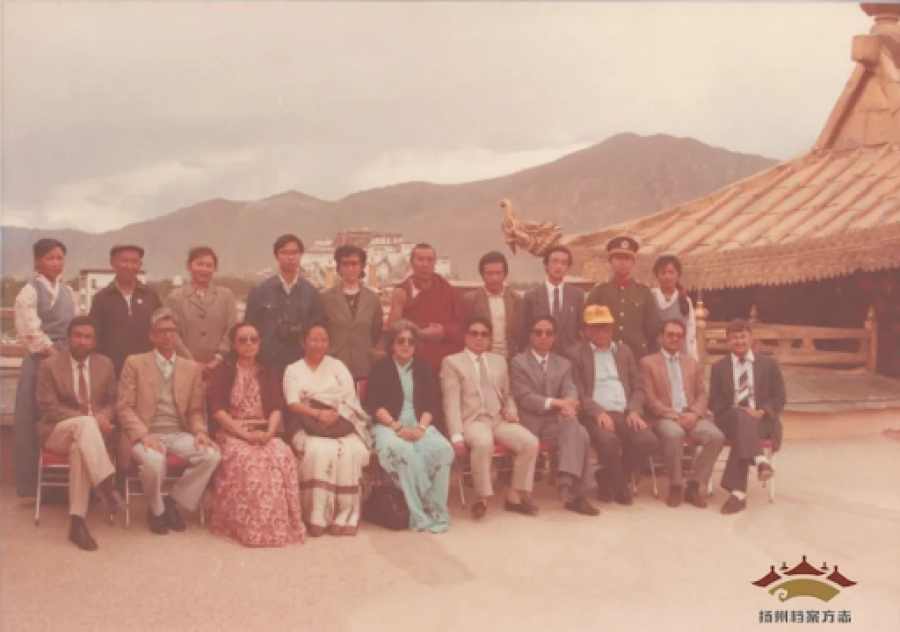Culture & Lifestyle
A Nepali translator in Tibet
In 1979, Gao A-qing also participated in the Nepal-China border demarcation and boundary post repair.
In 1972, Gao A-qing, born in Qingdao city of Shandong Province in China, was admitted to the foreign language training class at the Foreign Affairs Office in Tibet Autonomous Region to learn the Nepali language. She would later become a Nepali translator at the Foreign Affairs Office in Tibet and receive dignitaries from Nepal and other foreign countries during her 10-year tenure.
Becoming a Nepali language translator
In 1972, when the Foreign Affairs Office of the Tibet Autonomous Region recruited a group of foreign language cadres at the Xizang Minzu University, Gao applied and successfully passed the entrance exam. Among the selected three girls and five boys was Gao, who embarked on a journey to Tibet. Gao recalls that the foreign affairs cadres in Tibet were few in number and were in dire need of capacity building. Hence, they were among the recruited team of young people who would be trained.
After arriving in Lhasa, the group studied in the training class organized by the Foreign Affairs Office. The training class was similar to a technical secondary school. It was divided into two classes, English and Nepali respectively. Gao was assigned to a Nepali class and studied for two years. In 1974, after completing the Nepali course, the supervisor wasn’t satisfied with the group’s language proficiency, so they arranged for an internship at the Zhangmu Port, located at the southern foot of the Himalayas on the Nepal-China border. At the bottom of Zhangmu Port in Zhangmu Town, the closest point to Nepal.
A group of more than a dozen, including troops and students from other places, boarded a large and open truck to their destination. The road was rugged, with mountains on one side and a steep cliff on the other. If you are not careful, you may be buried here. On the way to Namtso Lake, Gao recalls witnessing a car suddenly driving across briskly and rushing down the cliff in the blink of an eye. Fortunately, their driver was skilled. The driver slammed on the brake, told them to get out of the car, and then reversed the car to avoid danger.

On the second day, halfway down the road, there was a sudden snowstorm, and the driver didn't bring a tire chain, so he couldn't drive up the ramp. They got out of the car and took off their coats, spreading them on the ground to prevent slipping. At three o'clock in the night, the car still couldn't go through, and she fell to the ground with cramps due to lack of oxygen. In a state of panic, her classmates took turns pinching her jaw. On a snowy night, everyone struggled until five o'clock in the morning. When it was daylight, the car climbed up the slope with a distance of only more than 100 meters. The road ahead was much easier and when they arrived at the accommodation, it was already dawn. After a short rest, they headed to the study site and practiced there for three to four months. With months of hard work, their spoken Nepali had significantly improved.
At the end of 1974, after returning from the internship, she was officially assigned to the Foreign Affairs Office of the Tibet Autonomous Region, where she was mainly responsible for receiving foreign guests and working with the Nepali Consulate General in Lhasa. The Foreign Affairs Office and the Consulate had a lot of work together. They met almost every week, and they often invited each other to participate in events and activities, such as large monthly banquets. At this time, Gao mainly did translation work. Because of this, during her work at Foreign Affairs Office, she remembers her life as much better than that of her husband and friends and she could also attend banquets from time to time and taste delicacies.
Gao was a Nepali translator only until 1982 when the Ministry of Foreign Affairs organized a group of English training courses especially for in-service cadres at the Chinese Foreign Affairs University where she was admitted and spent two years receiving a junior college diploma.
After 1978, Gao recollects that many foreigners visited Tibet. Although there were both official groups and tourists, the Foreign Affairs Office only attended to official visits. Gao participated in receiving foreign dignitaries such as US President George W. Bush, the princess of Iran, the king and princess of Nepal, etc. She recalls missing the first visit by King Birendra to Tibet but being able to be part of the second visit. At that time, the Protocol Department of the Ministry of Foreign Affairs also sent staff to receive the Nepali delegation as first-class protocol treatment. Gao recalls the standards being very high and the lineup was very large. Even the guard of honor from Beijing was received.
During her tenure in the Foreign Affairs Office, she had the honor to travel abroad as a translator, twice, with the friendship delegation of Tibet Autonomous Region twice. The first time was in April 1980, when she visited Nepal with a goodwill delegation and stayed there for 15 days. The second time was in late 1985, when Gao was part of a delegation that visited Nepal and Thailand.
Nepali interpreter at the Nepal-China border demarcation project

In 1979, Gao also participated in the Nepal-China border demarcation and boundary post repair at that time. The environment at the border area near Gyirong County was challenging for both teams. Gao was among the few female members in the project where she took part as an interpreter. She remembers being divided into seven or eight groups to work on different hills. They walked between the boundary pillars and would set up tents when suitable flat land was located in the wild after negotiations between the two countries. The tents of the two countries were separated, and there was a boundary in the middle. When they had common affairs to negotiate, they would go to the tent specially set up as a conference room to negotiate, and then return to their respective camps.
Gao vividly remembers an incident during this project. One afternoon, she suddenly heard a rattling sound from the mountain. The Nepali staff seemed very experienced and immediately called for her: “Miss Gao, the avalanche is coming, let's go down the mountain quickly, hurry up and withdraw!” When she heard this, she immediately reported to the team leader. Everyone was a little hesitant at first, thinking it was unlikely, but the Nepali side moved very quickly, and immediately started to retreat after informing Gao.
She firmly said to the team leader: "Look, they are all gone, it seems that it can't be fake!" Only then did the Chinese team pack and evacuate. The avalanche descended when the team was only halfway out of the site. Ice and snow poured down from the top of the mountain, making a rumbling noise, and instantly submerged the mountain where they were originally camping. Several people almost got buried under it all in an instant.
Gao recalls another time when she was shaken awake by a Foreign Affairs Office staff warning her about possible danger urging Gao to get dressed, prepare and not move until further instructions. Gao was frightened and immediately reached out for her dictionaries and books to evacuate with her. After waiting anxiously for a while, she was relieved to learn that the alarming lights from the mountains were fortunately just fireflies that happened to be passing through. Gao explains that Gyirong County had a different climate from most parts of Tibet. The temperature there was relatively high, the birds were heard singing, the flowers were fragrant, and there were trees and rhododendrons all over the mountain, which was a feast to the eyes. That night, the group of fireflies that were passing through was misunderstood to be an unidentified and misunderstood danger.
In 1988, Gao and her husband transferred back to Yangzhou City and went on to work as an English-speaking professional at the Foreign Economic and Trade Commission in Hanjiang, one of the three districts of Yangzhou City.
From setting foot on the vast land of Tibet in 1972 to leaving in 1988, during the 16 years, Gao reminisces the excitement and longing of youth when she first arrived. There were also the hardships and fatigue of working day and night, and the thrills and challenges on the way forward. She also possesses pride and satisfaction in completing each of her tasks. She believes that translation work is a bridge connecting China and the rest of the world. As a member of the translation team in the 1970s and 1980s, Gao’s work experience of the past 10 years and the details of life in Tibet have become an unforgettable part of her life.
This is an expert from a summarized translation of Gao A-qing’s orally narrated experience as a Nepali translator and pictures for the ‘Records of Yangzhou Archives’.
Translated and compiled by Aneka Rebecca Rajbhandari and Raunab Singh Khatri for The Araniko Project




 8.12°C Kathmandu
8.12°C Kathmandu












%20(1).jpg&w=300&height=200)

